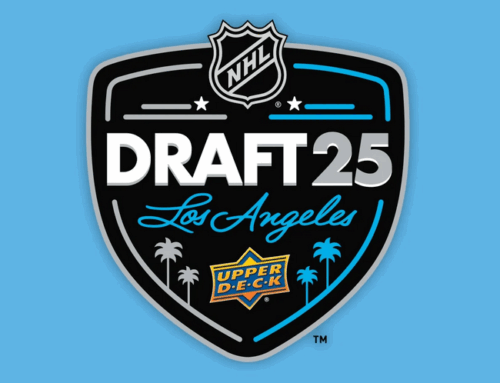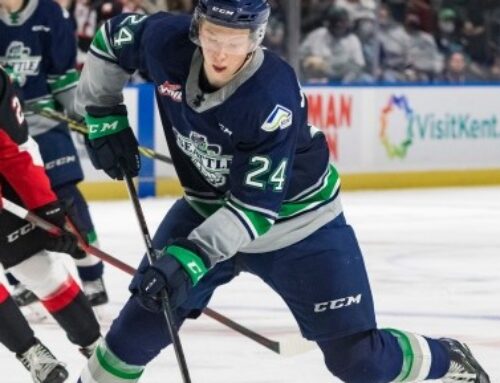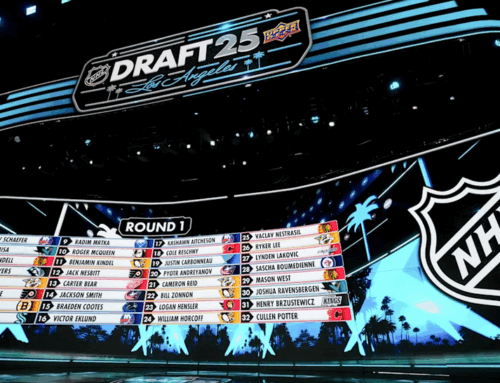Prospect Ramblings: How to Detect Multi-Cat Prospects
Ben Gehrels
2023-04-26
Welcome back to my weekly ramblings, where I provide news and updates, highlight intriguing prospects, and generally track the development of junior players across the hockey world.
This week, I will share some thoughts on finding value in multi-cat formats by exploiting category biases in your fellow managers; then we will link that discussion back to prospects and explore several telling signs that a prospect many hold multi-cat value (ie. more than raw scoring totals) if and when they make it to the NHL.
—
Like many poolies, I am currently straddling Yahoo! and Fantrax, with several leagues on each platform. It is a bit of a Mac vs. PC situation, isn’t it? Yahoo has a better interface and does everything for you but with reduced functionality (ie. no minors system), while Fantrax is a bit clunkier and more difficult to use but has way more options for customizing and tinkering. An interesting difference between the two is that Fantrax produces aggregate player scores that reflect how valuable they are in your specific format while Yahoo uses an overall ranking system that leaves managers to “guess” or estimate cumulative value.
This lack of an aggregate score in Yahoo leads to a quirk I have noticed over time in many of my multi-category leagues: many managers do not fully grasp the obvious but critical concept that all categories are equal. If my opponent wins goals while I win plus-minus, for instance, the score is 1-1. This speaks to the importance of closely studying the format when joining a new league. I have often found that my internal value system stems from a particular league or two and is a bit skewed when I come to a new league that includes or excludes key categories like face-off wins and blocks, for instance.
This leads to another point, which is that we sometimes equate “multi cat” primarily with hits—and to a lesser extent blocks and shots. As in, Player A is good in multi-cat because he hits, unlike Player B who does not. Without double checking, how would you respond to someone offering you Dylan Strome (WAS) for your Tanner Jeannot (TBL) in a league with Goals, Assists, Penalty Minutes, Shots, Special Teams Points, Hits, and Blocks?
You would probably decline that in your sleep. But here is how they shake out overall:
Jeannot (score: 54.68)
76 GP, 6 G, 12 A, 107 PIM, 107 SOG, 1 STP, 290 H, 62 B
D. Strome (score: 57.29)
81 GP, 23 G, 42 A, 24 PIM, 154 SOG, 21 STP, 20 H, 43 B
Because of Jeannot’s incredible rookie season with Nashville in 2021-22 (score: 71), he has a special place in the fantasy zeitgeist as a multi-cat unicorn. Yet while he is certainly elite in Hits and Penalty Minutes, his value elsewhere is surprisingly low: only one point on special teams, not even 20 points overall, and less than a shot and a half per game.
Meanwhile, although Strome has a poor reputation in fantasy and does not offer much by way of PIMs or hits, 65-point players don’t grow on trees. Plus, he was close enough to two shots/game not to be a drag in that category and boasts a hefty PPP total from playing on Washington’s top unit. Each player excels in two categories, and their value grades out as pretty much equal.
Of course, there are also track record and trajectory to consider—I have been burned by Strome too many times to trust him now, for instance—as well as the specific surpluses and deficiencies of your roster, but I think there is a small insight here: if hit-and-shoot grinders like Jeannot, Blake Coleman, Josh Anderson, Scott Laughton, and Lawson Crouse are being overvalued while more one-dimensional scorers like Strome, Jesper Bratt, Clayton Keller, Jonathan Huberdeau, and Johnny Gaudreau are being undervalued, perhaps you can use that discrepancy to your advantage.
In addition to the “light” and “heavy” peripheral guys on each end of the reputation spectrum, there are also a ton of players somewhere in the middle whose actual value in certain formats falls short of their perceived value. Let’s use Strome again and compare him to a supposedly elite center like Sebastian Aho (CAR), just for example:
Aho (score: 65.88)
75 GP, 36 G, 31 A, 42 PIM, 218 SOG, 19 STP, 59 H, 21 B
D. Strome (score: 57.29)
81 GP, 23 G, 42 A, 24 PIM, 154 SOG, 21 STP, 20 H, 43 B
Aho is a high-end sniper and has the edge in four categories, but Strome is an excellent playmaker and has the edge in three. As their overall scores indicate, there is not a huge gap overall between them in this format. Yet Strome might be available for free off the wire while Aho would cost a Ferrari plus your first-born child. Just something to think about.
I would love as much as the next manager to build a roster around, say, Timo Meier (NJD), J.T. Miller (VAN), Brady Tkachuk (OTT), Darnell Nurse (EDM), and Mo Seider (DET), because each of those players can score at an above-average to high-end rate while offering ridiculous totals in a variety of other categories. But the reality is that sometimes you have to pair a Jeannot with a Keller, for instance, to ensure you get a balance of scoring and physical stats.
My point is that perhaps you can find a slight edge in purposefully accumulating the light-peripheral scoring types devalued by other managers and then supplementing them with specialists like Rickard Rakell (3.0 shots/game), Jack McBain (3.71 hits/game), and Jared Spurgeon (2.3 blocks/game).
Go against the grain in fantasy, whatever that looks like, whenever you can.
—
Okay, now how does all of this play out in the prospect realm? Because of how limited publicly available stats are for leagues outside of the NHL, there is a giant question mark for most people around how many peripheral stats individual prospects produce at lower levels.
If you subscribe to the Fantasy Hockey Life Patreon, you can get access to an integrated prospect ranking that includes valuable peripheral data obtained via InStat. To attack this tricky issue of properly assessing multi-cat value in prospects, they have established a useful tiering system that balances point production with Blocks/Shots/Hits.
For managers restricted to publicly available data, that lack of information funnels us into exclusively (or at least heavily) considering raw scoring totals when assessing the value of a given prospect.
NHLe and PNHLe models take those totals, adjust them based on the league they were produced in, and then show us how many points that would directly translate to in the NHL (NHLe) or what they suggest a player’s peak point production might be once they make the NHL (PNHLe). These models, while not perfect, are extremely useful for ballparking relative value between prospects playing in vastly different contexts.
Like most managers, my general strategy when it comes to selecting and accumulating prospects is to gravitate towards players with a good pedigree/track record and high equivalency. I regularly scan Dobber’s top prospect list and Rank King’s PNHLe ranking for players having exceptional years whose reputation has not yet caught up to their performance/potential. The benefit to focusing on points only with prospects is that you stand a good chance of netting a player who will become a scoring star at the NHL level. Because those are much more rare than multi-cat grinders, it is relatively easy to supplement your high-scoring, one-dimensional prospects with wire fodder that helps balance your categories.
Every now and then you can see a Brady Tkachuk coming down the pipeline and feel reasonably sure that he will be a multi-cat unicorn. Words and phrases like “gritty,” “plays with an edge,” and “loves to throw the body” in scouting reports are excellent clues that a given player will garner extra value through hits at the next level.
Snipers are also fairly easy to detect because there tends to be tons of praise surrounding their shot: Koehn Ziemmer, Brayden Yager, and Will Whitelaw are a few examples from the upcoming 2023 draft. Managers can probably expect these players to exceed two shots/game and even push three once they hit the NHL given how much of their game is built around that particular skill. Young NHLers like Arthur Kaliyev, Cole Caufield, and Nick Robertson are good recent examples of players who shot and scored a ton in junior and are now reproducing those patterns at the highest level.
—
One final thought: while defensive defencemen and two-way forwards tend to drop in fantasy drafts because of their lack of high-end production, I have noticed over time that sometimes players with robust all-around skillsets discover a new offensive gear later on in their development. The first part gets them to the show; the second endears them to poolies.
Alexander Nikishin (CAR), for instance, scored 55 points in 65 games as a 22 year old this year, finishing 12th in PNHLe just behind Luke Hughes, Brandt Clarke, and Kevin Korchinski. My genius co-manager picked him up for us in a couple dynasties back in 2021-22 as a speculative multi-cat add. He was a big guy (6-4, 216 lbs) who played a physical game and racked up a lot of penalty minutes on top of scoring 12 points in 46 KHL games. The thought was that he could help us with peripherals if and when he made the NHL, even if he didn’t provide much scoring. One year later, he looks like a high-end defensive prospect.
Ditto for Stanislav Svozil (CBJ). His DP profile hints at the exact archetype/pattern we are zeroing in on here, describing him as a “defensive blueliner who possesses all of the tools to play an above-average offensive game if he can put it all together.” Like Nikishin, Svozil had the added mystique of playing in a professional European men’s league in his draft year, which is rare for 18 year olds, and so there were no well-established benchmarks to help project his future NHL performance. He then came over to North America and had a decent Draft+1 year, posting 41 points in 58 games—solid, not incredible by any means. But this year, playing on Connor Bedard’s Regina Pats, he put up 78 points in 56 games and was a serious offensive driver from the back end. He too looks increasingly like a high-end blueline prospect.
A forward who fits the same bill is Nikolai Kovalenko (COL). He was described as a “do-it-all top-nine winger with physicality and a scoring touch” and has been a slow-burn development project for the Avalanche. After four years of KHL seasoning, he took a noticeable step forward this year with 54 points in 56 KHL games. His draft reports dating back to his draft year mention increasing shot rates and physicality, but the points didn’t pop until 2022-23. Now the 23 year old is going to be a highly sought-after commodity in fantasy, assuming he crosses over to North America in the off-season.
Some other strong defensive or all-around players who might end up following similar trajectories:
Isaiah George (NYI)
Lian Bichsel (DAL)
Martin Kaut (SJS)
Joakim Kemell (NAS)
Ryan Chesley (WAS)
Carson Lambos (MIN)
Ethan Del Mastro (CHI)
Zach Ostapchuk (OTT)
Kaiden Guhle (MON)
Justin Barron (MON)
Brock Faber (MIN)
Jamieson Rees (CAR)
Thanks for reading! Follow me on Twitter @beegare for more prospect content and fantasy hockey analysis.





